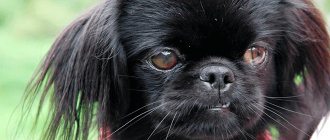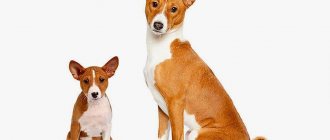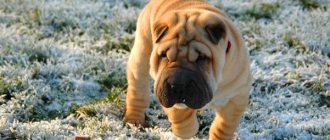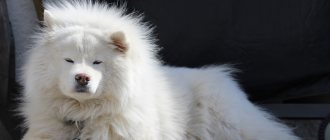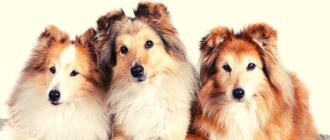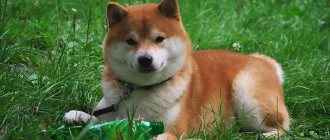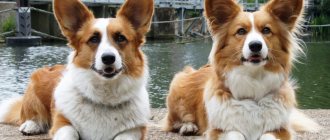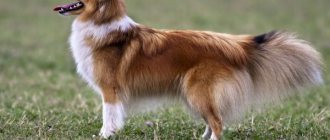Japanese dogs reflect the samurai spirit of the inhabitants of the Land of the Rising Sun. They are reserved, independent, selflessly devoted to their owners and have exceptional fortitude. This small group contains a record number of breeds, whose loyalty and ingenuity were reflected in films and captured in monuments.
Breeds are conventionally divided into two groups: native Japanese and those bred by crossing with foreign relatives. The breeding of the former is controlled by the Association for the Preservation of the Japanese Dog (Nippo). They are also considered national treasures of Japan.
In the review I described all Japanese dog breeds with photographs . You will learn about the similar and different features of the appearance and character of each representative. I also indicated the key points in care, maintenance and education.
How much does a Shunsuke puppy cost and where can I buy him?
Firstly, in the photo you don't have Shunsuke, but Boo. Boo is an American Pomeranian, in the now popular “bear cub” type, the original breed is a German dwarf Spitz. Pomeranian is an unofficial name, as it is customary to call dwarf German Spitz and small (less often medium) Spitz, the name comes from the name of the region in Germany (Pomerania), the country of origin of the breed. Shunsuke is the nickname of a 9-year-old German dwarf Spitz of the European “fox” type.
Shunsuke the dog
Posted by Domsobaki October 7, 2016
A Japanese dog named Shunsuke has gained worldwide fame thanks to his owner. Now many are looking for where to buy this cute breed. If we talk about how to choose a puppy and what to pay attention to, as well as if you want to get answers to questions that are not covered in this article, you should use the search for this project or leave comments under the article.
It will be no less interesting to read other articles on this site in order to get an idea about other breeds and understand which of the currently available popular options may be a good choice for permanently living in an apartment or private house.
Japanese dog Shunsuke history, parameters, size, weight, height
Shunsuke is a Pomeranian dog that lives in Japan. She is 9 years old. Height is about 20 centimeters. Weight is about two kilograms.
The dog gained fame after a TV show with her participation. In Japan, calendars and books with her image began to be sold. The owner maintains a page for her pet on Twitter, which has more than 80 thousand subscribers.
Shunsuke breed characteristics, care and feeding, how long he lives, how to care for him, diseases, another name
The Pomeranian is a small fluffy dog. Her height is from eighteen to 22 cm. The weight of the Spitz is from one to 3 kg.
This breed lives up to 14 years, but some individuals can live up to 20 years. It is better to feed your baby natural food or high-quality dry food.
The dog is very smart and easy to train. She is walked at least twice a day. Long hair is often combed.
It is necessary to carefully monitor the health of the animal; it may have problems with teeth, fragile bones, and problems with joints. With an abundant diet, animals become obese and the functioning of the gastrointestinal tract is disrupted.
The Pomeranian is sometimes called the German Spitz, but the breeds are different (Pomerania is a region in Germany). The German Spitz has a more elongated, fox-like muzzle, and guard hair predominates.
Shunsuke and Pomeranian differences, the same thing or not
Shunsuke is a Pomeranian who has been cut in a funny way so that he looks like a stuffed animal.
How to choose a dwarf Japanese spitz puppy?
When choosing an orange, you need to pay attention to a number of points:
- Living conditions (cleanliness, convenience, comfort).
- The parents' appearance must meet the standard.
- A puppy is healthy if it is inquisitive, playful, and constantly on the move.
- The pet's nose is cold and wet, the belly is soft, the skin is healthy, and the coat is snow-white.
- Veterinary passport and pedigree available.
- The baby's age is at least 1.5-2 months.
It should be taken into account that Japanese Pomeranian males are larger, their coat is more elegant than that of girls. When choosing a pet, you need to look at the entire litter, regardless of what kind of puppy the breeder offers.
American Akita
The American Akita was bred from the Akita Inu. The first representatives from Japan were brought to the United States after World War II, where they quickly became popular.
To create a new type of dog, Americans crossed Akitas with German shepherds and mastiffs. The resulting breed was called the "Big Japanese Dog". It differs from its eastern relatives in its massive build, variety of colors and more docile character.
Otherwise the breeds are similar. American Akitas are also freedom-loving and independent, like their Japanese relatives. Maintenance and care are also the same: a large Japanese dog is kept in an apartment or outside the city, washed several times a year and combed every week.
Factors on which the price of a dog depends:
- Place of purchase. You can buy a puppy from your own hands or online without documents and vaccinations for 3,000 to 10,000 rubles. Here everything depends on the arrogance of the owners. Most often, such puppies appeared “by accident.” No one cared about their lineage or paid enough attention to their care. When buying from nurseries or clubs, you additionally pay for pedigree, vaccinations and passports. On average in Russia, a Shunsuke dog costs from 10,000 to 20,000 rubles.
- Color of the puppies. The more unusual the color, the higher the price. Those who breed Spitz dogs try to diversify their colors and achieve a unique color. Therefore, for originality you will have to pay from 15,000 to 25,000 rubles.
- Titles. And even if the baby has not yet managed to take part in exhibitions and win the love of the judges, his parents did it for him. Puppies of titled dogs cost from 25,000 rubles to infinity. But they will also very quickly help you “recoup” the money spent through breeding.
Education and training
The main thing in raising a Japanese Spitz is the ability to quickly establish emotional contact. If the dog loves the owner and trusts him, there will be no difficulties in training. And vice versa: if the “Japanese” failed to find his niche in the new family, even an experienced dog handler will not be able to turn him into an obedient companion. So as soon as your four-legged friend moves into your home, look for a special key to his heart, because then it will be too late.
Do not confuse warm, trusting relationships with connivance. Undoubtedly, the Japanese Spitz is sweet and charming, but in this world he is not allowed everything. And since punishments with these Asian cunning people do not work, try to put pressure on them with a serious tone and convincing demands. In particular, the dog must clearly understand that picking up any objects from the ground and accepting treats from strangers is taboo. By the way, do not expect that your pet will demonstrate standard obedience in all life situations without exception. The Japanese Spitz is too smart to enjoy the role of a blind performer: he agrees to be friends with you, but not to run for slippers and chips for “Your Majesty.”
The performance of the “Japanese” is phenomenal, which was clearly confirmed by Nikolai Pavlenko’s charges, so don’t be afraid to overwork your shaggy pupil. It’s worse if he loses interest in training, so include a good old game in the training process more often so that your little student doesn’t get bored. Typically, a two-month-old puppy is ready to respond to its name and knows how to use a diaper or litter box correctly. The third and fourth months of life are the period of familiarization with the rules of etiquette and the commands “Ugh!”, “Place!”, “Come to me!”. By six months, Japanese Spitz dogs become more diligent, they are already familiar with the street and understand what is expected of them. Consequently, this is the optimal time for mastering obedience commands (“Sit!”, “Near!”, “Lie down!”).
As for socialization, a principle common to all breeds works here: more often simulate situations that force the pet to adapt to changed environmental conditions. Take him for walks to busy places, arrange meetings with other dogs, ride on public transport. The more new unusual locations, the more useful it is for the “Japanese”.
Shunsuke: a mystery from Japan
What color is Shunsuke?
Load more
Shunsuke's country of origin?
Load more
What type of coat does the Japanese Shunsuke have?
long, hard, straight with thick undercoat
Load more
The cute Japanese dog Shunsuke has won the sympathy of millions of Internet users. The sight of the plush toy touches them so much that they want to know what breed it is, how much it costs and where they can buy it.
Health and disease of Japanese Spitz
The breed does not have any terrible fatal diseases that are inherited, but this does not mean that the animal is not capable of getting sick with anything at all. For example, Japanese Spitz dogs often experience vision problems. Retinal atrophy and degeneration, cataracts and glaucoma, entropion and eversion of the eyelids are not such rare phenomena among representatives of this canine family. Patella (luxation of the kneecap) is a disease that, although not as common, can still be found in Japanese Spitz dogs. As for acquired diseases, you should be most wary of piroplasmosis and otodectosis, various anti-tick medications will help protect against them.
POMSKY RUSSIA LOVELY PET
We are pleased to announce! Our Pomsky breed group has received initial recognition from 7 cynological organizations, and now has the right to be called an independent breed with an official standard! and take part in exhibitions! AUTHOR OF THE POMSKIE BREED IN RUSSIA - KUDRYASHOVA T.E. kennel "LOVELY PET", CO-AUTHOR OF THE BREED - ASTAKHOVA V.I. p-k "NORD SOUL". -ROO NKL, -ASRK NRKA, -ROO NSKTs, -DWCU (USA), - UCI "Good World", IKU SKOR-breed group, - WCHSA (Bulgaria)
We inform you that we managed to organize and register the Pomsky breed club "Russian Pomsky Club" / Russian Pomsky Club (RPC), which allows us to organize special breed exhibitions and Pomsky shows in Russia and abroad, as well as enter into partnership agreements with breeds Pomsky clubs in other countries. All members of the Association of Pomsky Owners and Breeders are also members of the Russian Pomsky Club. The rules for joining RPC remain the same as in POBAR
Pomskys were specially bred as a cute miniature companion. To do this, representatives of one fifth of the group were crossed - Pomeranian Spitz and Siberian Huskies. Small dogs with the characteristic appearance of a husky are often confused with other mestizos of this breed - the Alaskan Klee Kai and the Siberian mini husky.
In 2011, the famous breeder Teresa Peterson from Burnsville (North Carolina, USA), specializing in breeding huskies, became interested in the possibility of breeding a new breed, and after 2 years the first litter was obtained. At the same time, similar crossbreeding was carried out in Russia (Lovely Pat’s nursery, Moscow region). For two years, all the puppies received remained in the nursery for further breeding work, and for the next 3 years the best representatives were selected for the further formation of the breed.
Many breeders followed the example of Peterson and Kudryashova, and after some time there became a need for an organization that would monitor their activities. Thus, in 2013, the Pomsky Club of America (PCA) was organized, whose task was to maintain selection at a high level and the desire to achieve recognition of the Pomsky as an independent breed with its own standard, and in 2022, the Association of Pomsky Owners and Breeders in Russia-Pomsky was organized in Russia Owners & Breeders Association Russia – POBAR Pomsky Owners & Breeders Association Russia – POBAR
So far, Pomskies are not recognized by the canine societies RKF and FCI, and the activities of breeders are supported only by ROO NKL OPK KC STOUT (Russia), RCA and ASNS - American Hybrid Dog Club, DWCU-USA and the POBAR Association, which is a member and official representative in the Russian Federation , international organization Dog World Cynological Union "DWCU" (USA), UCI-International Union of Kennel Clubs Germany, IKU SKOR -International Kennel Union Union of Cynological Organizations of Russia-breed group.
In Russia, Tatyana Evgenievna Kudryashova has been officially engaged in the selection and formation of the Pomsky breed since 2013, at the POMSKY RUSSIA LOVELY PET nursery.
We are glad to welcome you to the website of the Lovely Pet nursery! Our nursery was founded in 2009. It is registered by NKPTS (Russia), DWCU (USA), DWKC (Great Britain), IKU SKOR (Russia), UCI Dobry Mir (Russia). He is also registered and is a member of the Association of Pomsky Owners and Breeders in Russia (POBAR). On the POBAR website you can view all officially registered nurseries participating in the breeding program for the formation of the Pomsky breed, familiarize yourself with the breeding status and general pedigree database https://pomskypedigree.ru/pomsky
By visiting the pages “our graduates” and “our producers”, you will be able to get acquainted with the dogs of both the kennel itself and the dogs of our breeding living in their new families. On the “news” page you will find information about upcoming exhibitions, as well as about the births of new litters. On the Pomsky Puppies page you will find all the information you need about the puppies for sale.
Be sure to read the very important information about the conditions for purchasing and reserving puppies in our kennel on the “conditions of purchase” page. Next, you can study the conditional standard of the Pomsky breed group.
The main direction of our nursery is the formation of the Pomsky breed and the consolidation of breed genetic characteristics. Due to the fact that the breed is new and little studied, it does not have an approved standard, but based on the genetic data obtained by the breeder by hybridizing two breeds, each nursery has a conditional standard.
POMSKI STANDARD
Country of origin: Russia, USA
Purpose: companion dog
SKOR-IKU classification: 5 group “Companion dogs” without working tests
General appearance: a medium-sized, active dog with a lively temperament, strong build, with moderate (not light) bones, sexual dimorphism is well expressed. Spitz-shaped with the color of a Siberian Husky.
Behavior and character: highly trainable and completely people-oriented. The dog is quite energetic, but not willful like a husky. Does not require much physical activity, but can be used in sports. Grooming is minimized. Stress-resistant and suitable for keeping in urban environments.
IMPORTANT PROPORTIONS:
When viewed from the side, the length of the body, measured from the humeroscapular joints to the ischial tuberosities, is slightly greater than the height of the dog at the withers;
The length of the muzzle from the tip of the nose to the stop is equal to the length of the skull, measured from the stop to the occipital protuberance.
Head : proportional to the body.
Skull : Medium in size, proportional to the body, slightly rounded and tapering from the widest point to the eyes.
Stop : Well defined.
A little bit of history
After carefully studying various sources, the reader will discover that the Shunsuke dog is not a new breed of dog; after all, Shunsuke is a bear-type Pomeranian with an unusually short haircut (his photos can be found on Twitter, Instagram and other social networks). Shunsuke is a 9-year-old dog who lives in Japan and became a celebrity there thanks to his participation in a television show.
Judging by the numerous photos posted by “Mama Shun” from Japan, the haircut turned out to be so successful and pretty that the breed became difficult to recognize.
It turns out that the Pomeranian Spitz has been observed to be related to strong and hardy sled dogs. When the Japanese breed appeared, namely Shunsuke, also known as the “Pomeranian,” no one can say for sure. During excavations in the northern countries, archaeologists have found the remains of pets from the Stone Age. If you study the ancient ceramics of Greece and Rome, you can see very similar images of Spitz dogs.
Spitz dogs have taken root in different countries, but have become especially popular in the Baltic countries, Northern Europe and Russia. Breeders were involved in the formation of the breed in Germany and England.
Sakhalin Husky
The Japanese call Sakhalin or Gilyak Laikas Karafuto-ken. Initially, the breed originated in the Amur region and Sakhalin. But in the 30s of the 20th century they were purposefully exterminated in their homeland. At the same time, the dogs were taken to Japan, where they were revived.
Sakhalin Huskies are considered an endangered breed. Work is still underway to restore and increase the number.
Sakhalin residents are sled dogs. They were also used to bait bears and sea animals. They are smart, brave and very resilient. In terms of working qualities, they are superior to Siberian Huskies, Malamutes and other breeds.
The breed went down in history thanks to an amazing incident. In 1958, Japanese researchers had to leave 15 Sakhalin huskies in Antarctica. Scientists expected to pick them up soon, but due to worsening weather they were able to return only a year later. Surprisingly, people found two surviving dogs. In honor of them and the dead dogs, a monument was erected in Japan, and two films were made: “Antarctica” and the American remake “White Captivity”.
History of the Japanese Spitz breed
Japanese Spitz
Japanese Spitz were presented to the world by the Land of the Rising Sun between the 20s and 30s of the 20th century. The East is a delicate matter, so it is still not possible to get information from Asian breeders about which specific breed gave these charming fluffies a start in life. It is only known that in 1921, at an exhibition in Tokyo, the first snow-white “Japanese” was already “lit”, whose ancestor, most likely, was a German Spitz imported from China.
Starting from the 30s and up to the 40s of the 20th century, breeders intensively pumped up the breed, alternately adding to it the genes of Spitz dogs of Canadian, Australian and American origin. It is to them that the Japanese Spitz owes its distinctly glamorous appearance, with a slight slant towards orientality. At the same time, the official recognition of animals by canine associations proceeded gradually and not always smoothly. For example, in Japan, the breed standardization procedure was carried out already in 1948. The International Canine Association delayed until the last minute, but in 1964 it finally gave in and proposed its own version of the breed standard. There were also those who remained steadfast in their decision. In particular, specialists from the American Kennel Club categorically refused to standardize Japanese Spitz dogs, classifying the animals as a member of the fairly well-known and numerous clan of American Eskimo dogs at that time.
Japanese Spitz arrived in Russia after the collapse of the USSR together with circus trainer Nikolai Pavlenko. The artist did not intend to engage in breeding activities, and he needed dogs exclusively for performances in the arena. However, after a couple of successful performances, the trainer had to reconsider his views. Thus, the family of circus Spitz dogs received new additions from several purebred producers, who later gave birth to the majority of domestic “Japanese”.
Interesting information: after photographs of Philip Kirkorov hugging a Japanese Spitz appeared online, rumors began to circulate that the king of the Russian pop scene got his pet from Pavlenko’s troupe. The trainers allegedly did not want to part with their ward for a long time, stubbornly rejecting the star’s generous offers, but in the end they relented.
Shunsuke breed: description and main characteristics
According to the standard, Shunsuke Spitz is 18-22 cm tall and weighs 1-3 kg. Color can vary in the following tones:
- snow white;
- black;
- spotted;
- golden red;
- chocolate;
- sable;
- cream;
- blue and tan;
- blue;
- two-color.
The Shunsuke puppy has remarkable features: upturned nose, short muzzle, soft coat. The pet's head is rounded with triangular pointed “erect” ears. The eyes are small, located close to the nose. In parallel with the upturned nose is a slightly upturned chin. The Japanese dog Shunsuke has particularly fluffy hair on its paws and tail.
The long-familiar new breed of Shunsuke dog lives up to 14 years, although there are animals that have lived up to 20 years.
If you carefully examine Shunsuke and numerous photos, you will notice a feature that distinguishes bear-type Pomeranians from other pets of dwarf breeds: chubby cheeks. They are formed due to extremely thick hair on the cheekbones. This trait can be considered an achievement of breeders.
Appearance of a Japanese Spitz
Japanese Spitz puppy
This smiling “Asian”, although it seems to be an exact copy of the German and Florentine Spitz, still has some exterior features. For example, compared to its European relatives, it has a more elongated body (the ratio of height to body length is 10:11), not to mention the distinctly oriental shape of the eyes, which is atypical for Spitz-type dogs. The snow-white coat of the “Japanese” is another identifying feature of the breed. No yellowness or transitions to milky or creamy varieties are allowed, otherwise it will not be a Japanese Spitz, but an unsuccessful parody of it.
Head
The Japanese Spitz has a small, rounded head, somewhat widening towards the back of the head. The stop is clearly visible, the muzzle is wedge-shaped.
Teeth and bite
The teeth of representatives of this breed are not large, but quite strong. Bite – “scissors”.
Nose
The miniature nose looks emphatically round and is painted black.
Eyes
The Japanese Spitz's eyes are small, dark, slightly slanted, with a contrasting rim.
Ears
The dog's tiny ears are triangular in shape. They are placed at a fairly close distance from each other and look straight ahead.
Neck
The Japanese Spitz has a moderately long, strong neck with a graceful arch.
Japanese Spitz face
Frame
The body of the Japanese Spitz is slightly elongated, with a straight, short back, convex lumbar region and wide chest. The dog's belly is well adjusted.
Limbs
The shoulders are set at an angle, the forearms are straight with the elbows touching the body. The hind legs of the “Japanese” are muscular, with normally developed hock joints. Paws with hard black pads and claws of the same color resemble those of a cat.
Tail
The tail of the Japanese Spitz is decorated with long fringed hair and carried over the back. The tail is set high, length is medium.
Wool
The snow-white “coat” of Japanese Spitz is formed by a dense, soft undercoat and harsh outer hair, standing upright and giving the animal a pleasant airiness. Areas of the body with relatively short hair: pasterns, metatarsals, muzzle, ears, front part of the forearms.
Color
Japanese Spitz can only be pure white.
Kishu
Kishu is another ancient breed from the Land of the Rising Sun, recognized as a national treasure. It has the typical external features of Japanese breeds: a triangular head, pointed erect ears, a curved tail and double coat. The color is most often white, but there are also representatives with a red or zone color.
Kishu is a rare breed. There are not many dogs even in Japan: about 11–13 thousand. And outside the country they are generally difficult to meet.
Despite their average size (49–52 cm), kishu are fearless hunters of large animals. They bravely drive bears and wild boars, hold them until the hunter arrives, jumping onto the back of the prey and clinging to it with their teeth. Pets can also guard the territory or herd livestock.
Kishu are unpretentious and can live in the harshest conditions. They don't care about heat or cold. But minimal care is needed: washing once every couple of months, weekly brushing, brushing teeth and ears, and trimming nails as they grow.
Breeds of white dogs with names and photos.
Photo of Japanese Spitz
Defects and disqualifying defects of the breed
Defects affecting the exhibition career of a Japanese Spitz are considered to be any discrepancies with the standard. However, most often the score is reduced for deviations from the standard bite, excessively curled tails, excessive cowardice, or, conversely, a tendency to make noise for no reason. Complete disqualification usually occurs for individuals with drooping ears and a tail that is not carried on the back.
Advantages and disadvantages of the breed
Although the Japanese dog breed, Shunsuke, which is still a bear-type Pomeranian, has conquered the world community, it has its pros and cons.
The advantages of the breed include:
- intelligence;
- loyalty;
- devotion;
- ease of care;
- fearlessness.
Disadvantages of breeds often include:
- loud and ringing barking;
- shedding with a huge amount of “lost hair”;
- cockiness (in relation to larger relatives);
- potential for injury;
- high price.
Advantages and disadvantages of the Japanese Spitz
Like any breed, Japanese Pomeranians have their advantages and disadvantages. Most owners name the following advantages of decorative dogs:
- perky disposition;
- love of life, positive mood;
- loyalty to the owner;
- lack of anger and aggression;
- presence of a protective instinct;
- cleanliness;
- excellent physical shape.
The presence of disadvantages in the character and behavior of the Japanese Pomeranian largely depends on upbringing, education and training.
Disadvantages of the Japanese:
- do not tolerate loneliness well;
- prone to escape;
- touchy;
- shy;
- cannot concentrate during classes;
- love to be the center of attention.
Japanese Terrier
This breed is the only one of the terrier group bred in Japan. Their breeding began at the beginning of the 20th century. The goal was to get a decorative dog that would easily adapt to life in densely populated cities.
During breeding, Italian Greyhounds, Smooth Fox Terriers, Manchester Terriers and small aboriginal dogs were crossed. The result was a miniature dog (30–33 cm and 2–4 kg), with a compact body, long legs and very short hair (up to 2 mm).
The Japanese Terrier is easily distinguished by its unique tricolor coat. The head is decorated with a black mask with red and white spots, and on the light body there are dark or reddish-brown markings.
The Japanese Terrier is an excellent dog for an apartment and a family. He is friendly, playful, and gets along with children. However, it can chase cats and rodents, and is wary and somewhat cowardly with strangers. The dog is also easy to care for: weekly brushing with a soft brush and occasional washing are enough. The only thing is that the pet cannot stand the cold, so from autumn to spring you will need clothes.
On topic: Varieties of terriers
History of the breed
No one can say with certainty what breeds, other than Pomeranians, were used by breeders to create Japanese Spitz dogs. It is believed that they have the blood of the Samoyed husky and Spitz dogs of Canada, the USA and Australia. For mating, individuals with snow-white fur and medium body size were selected.
After the Spitz standard was adopted in Japan in 1948, they began to be distributed throughout the world. The FCI recognized the breed in 1964. Only American clubs have remained on the sidelines, which consider Japanese Pomeranians to be too similar to Eskimo dogs.
Japanese Pomeranians were brought to Russia by circus trainer N. Pavlenko. At first they were used only for performing in the arena, but later, when they were finally convinced of their artistry, they took up breeding work. Several purebred sires gave rise to the Russian branch of Eastern Pomeranians.
Pet character
“Pomeranian” Shunsuke is becoming popular in Russia, so many people get this cute dog as a “companion”. A Shunsuke puppy, and even an adult, will defend its owner to the death. Just look at the photo where the “mini bear” considers himself the largest dog in the whole world. This breed has a lot of courage and devotion.
The Shunsuke dog breed is distinguished by its nobility, taken from its northern ancestors. Over time, pets adopt some of the character traits of their owners. The Shunsuke breed can make friends with children, but children must understand that Spitz are not toys, but living animals.
Character of the Japanese Spitz
It cannot be said that these snow-white fluffies are Japanese to the core, but they still got a piece of the Asian mentality. In particular, Japanese Spitz know how to competently dose their own emotions, although the signature smile from ear to ear literally does not leave the dog’s face. Idle talk and vanity among representatives of this breed is an exceptional phenomenon and is not welcomed by exhibition commissions. Moreover, a nervous, cowardly and barking animal is a classic Plembrak, which has no place in the honorable ranks of Japanese Spitz.
Fluffy cutie
At first glance, this elegant “Asian” is friendliness personified. In reality, Japanese Spitz trust only members of the family in which they live, and are not at all happy with strangers. However, this does not mean that the dog will demonstrate its own hostility to everyone. The correct “Japanese” masterfully hides his dark essence and the negative feelings overwhelming him. In relations with the owner, the pet, as a rule, is patient and never crosses the cherished line. Do you want to play with your fluffy? – You’re welcome, the Spitz will gladly support the company! Tired and want to retire? – No problem, being intrusive and pestering is not in the rules of this breed.
Japanese Spitz easily get along in a dog group, especially if the team consists of the same Spitz. Dogs also have no friction with other pets. This “clump of fluffiness” effortlessly finds an approach to both cats and hamsters, without trying to encroach on their life and health. Dogs have a fairly even relationship with children, but do not perceive them as dumb nannies. The fact that an animal steadfastly endures uncomfortable hugs and other not-so-pleasant manifestations of children’s feelings does not oblige it to dissolve in every two-legged creature.
Many Japanese Spitz are wonderful actors (the circus genes of the first Russian “Japanese” will definitely remind you of themselves) and even more wonderful companions, ready to follow the owner even to the ends of the earth. By the way, if you take the time to instill watchdog habits in your ward, he will not let you down either and will notify you in time about the impending “robbery of the century.”
An important point: no matter how universally charming your pet may be, get ready for the fact that from time to time he will “put on the crown” to prove to the world that even in a small body the spirit of a majestic samurai can hide. It looks funny, but you definitely shouldn’t condone such behavior: there should be only one leader in the house, and this is a person, not a dog.
Shikoku
Shikoku or Kochi looks like a wolf. And has the same endurance, strength and flexibility. The breed originated in the Middle Ages. It was originally used for hunting wild boar and deer. Today, dogs are also used to catch animals, and also to protect the territory and are simply kept as pets.
The Kochi Inu is another native Japanese breed included in the Nippo registry. In 1938 it was recognized as a national monument. Unfortunately, there are not many Shikoku dogs: there are about 7,000 registered dogs in the country.
Shikoku is a medium-sized dog: 16–26 kg and 49–52 cm. It is distinguished by thick, coarse hair with abundant undercoat and “wild” colors: red, black, brown or sesame. Whitish hairs on the sides are required - urajiro.
Shikoku is perhaps the most docile dog among the native Japanese breeds. She is people-oriented, attached to her owner, and friendly to strangers. She learns easily and loves to work, she is not as stubborn and independent as other “Japanese”. However, it is aggressive towards other animals, so early socialization is needed.
It is better to have a Kochi-ken outside the city. But an apartment is also suitable, provided there are many hours of daily walking. Pets are clean: it is enough to wash them 3-4 times a year and brush them once a week.
Features of maintenance and care
To keep the snow-white coat of the Japanese Pomeranian in perfect condition, you need to create comfortable conditions for it. The dog cannot live on the street or in an enclosure; he is housed in a house or apartment, where the owners create a cozy corner with a bed, a place for feeding and a toilet.
The pet needs regular and long walks, since its energy and physical condition do not allow it to sit still. The Japanese coat is thick and dense, so in winter the dog does not need special clothing. In spring or autumn, in order to keep the coat snow-white, wear a light overall that does not allow moisture to pass through, but does not hinder the animal’s movements. In cold weather, it is worth insulating nursing bitches by putting blankets on them.
Eye and ear care
Japanese Pomeranian puppies have very sensitive eyes that often become inflamed and watery. Every day you need to wipe them with cotton pads soaked in boiled water. If a speck gets in, wash it with a decoction of chamomile. If the cornea turns red and the discharge from the eyes becomes purulent, you should consult a veterinarian.
The pet's ears are examined every week. Do not get carried away with cleaning and use cotton swabs for this purpose. Only visible dirt is removed from the ears using cotton pads or swabs soaked in a special lotion. An unpleasant odor from the ears is an alarming symptom that requires immediate contact with a veterinary clinic.
Nail care
When a Japanese Pomeranian spends a lot of time outside, nail care is minimal - they wear down naturally. Just don’t forget about dewclaws that don’t come into contact with a hard surface.
If the claws grow long, they are shortened with a nail clipper monthly or referred to a professional groomer.
After returning from a walk, you need to wipe your paws. The fur between the pads is carefully trimmed as it grows.
Grooming, shedding
Japanese Pomeranians have a unique coat - it does not smell like a dog, and retains its ideal appearance for a long time without additional measures. This is explained by the fact that wool has a natural impregnation that repels moisture and dirt.
Daily brushing is only required during the shedding season. The first occurs at 7-11 months, and until this time the puppy is covered with fluff, which is treated with a special brush or slicker.
Feeding
The Japanese Pomeranian does not have a tendency to allergic reactions, so creating a menu for it is not difficult. The breed is not picky and has a good appetite, but each pet is individual and requires a special approach. At first, the puppy is given the same diet that he had before moving to a new home. Babies are fed natural or industrial food. Dry granules should not contain dyes or preservatives. For snow-white Japanese dogs, choose super-premium or holistic dog food with light coats. Normally, they should consist of 30-40% beef, lamb, chicken or fish.
With natural feeding, meals are prepared that include:
- lean meats;
- boiled sea fish and chicken;
- rice, buckwheat;
- vegetables (zucchini, broccoli, cucumbers, green peppers);
- eggs.
Apples and pears are suitable as treats; they are given rarely and in small quantities. Orange and red vegetables and fruits are fed with caution, as the natural dye can change the color of the Japanese coat, giving it a yellowish tint. They are rarely indulged in crackers and bones; more often they are treated to cleanse the teeth of plaque and tartar.
The diet changes as the puppy grows:
- up to three months they feed 5-6 times a day;
- at 3-6 months – 4 times;
- from six months – 3 times;
- from one year onwards – twice a day.
To help maintain proper posture for your Spitz, food and water bowls are placed on an adjustable stand.
Bathing
You should not bathe your Japanese Pomeranian more than 4-5 times a year. Before the procedure, it is combed, removing accumulated debris from the fur. Wash with a special shampoo, then treat with balm, which adds shine and protects from tangling. But it should be remembered that the abuse of conditioners and balms does not have the best effect on the structure of the hairs. To dry your dog, you first need to blot it with a towel, then use a hairdryer. It is very important to dry the wool well so that fungus and parasites do not appear in a humid environment.
Diseases and vaccinations
Japanese Pomeranians have strong immunity, rarely get sick, and are resistant to viruses. They have no predisposition to genetic diseases. Due to their physiological characteristics, representatives of the breed are at risk of developing ailments:
- conjunctivitis;
- hip dysplasia;
- epilepsy;
- thyroid diseases.
To protect against viruses that cause severe pathologies, pets need to be vaccinated. Like other dogs, Japanese Pomeranians are required to receive the following vaccinations:
- at 2-2.5 months – complex from hepatitis, parainfluenza, plague and enteritis.
- at 3 months – revaccination;
- at 6-7 months – from rabies;
- per year and then every other year - repeat complex vaccination.
Two weeks before the vaccination procedure, the Japanese Pomeranian is given anthelmintic drugs and body temperature is monitored.
If the epidemiological situation is unfavorable, pets are additionally vaccinated against demodicosis and lichen.
Fighting ticks and fleas
After each walk, the Japanese dog's coat must be carefully inspected. If the dog walked through the forest or tall grass, there is a risk of being attacked by ticks. As a preventive measure, you need to buy a collar, drops or long-term spray. When interacting with other dogs, the Japanese Pomeranian can “get” fleas. The fight against them is similar to that carried out against ticks. They produce different forms of drugs that can be used against each of the skin parasites separately or as a combined means of protection.
Fight against worms
The presence of internal parasites (worms or helminths) in the gastrointestinal tract of the Japanese Pomeranian is signaled by vomiting, diarrhea, lethargy, rumbling in the stomach or increased appetite. To determine the lesion, it is necessary to conduct a laboratory analysis of stool.
To avoid infection with parasites, follow several preventive measures:
- They feed only fresh products.
- Keep the dishes clean.
- Do not allow your pet to come into contact with the feces of other dogs.
- They are brought in regularly for preventive examinations.
- Anthelmintic medications prescribed by your veterinarian are given every three months.
Education and training
Japanese Pomeranians are smart and diligent, but keeping their attention during training is very difficult. To make the training as effective as possible, puppies are motivated with treats and toys, and the lesson itself is carried out in the form of a game. It is unacceptable to hit or scold a pet. One stern look is enough to show him that he is wrong.
At the age of three months, a Japanese Pomeranian can master the commands “Sit!”, “No!”, “Place!”, “Near!”, “Voice!”.
The puppy needs to be socialized as early as possible so that there are no problems with communication. After vaccinations and quarantine, he is introduced to public transport and crowded places. The faster the addiction sets in, the calmer the dog will behave in any situation.
If you encounter problems while training your Pomeranian, you should seek help from a dog trainer or take group training courses.
Dog mating
Despite the fact that Japanese Pomeranians reach puberty at 8-12 months, the optimal age for mating is 2-2.5 years. Girls are untied during their third or fourth heat, which lasts 20-25 days. Earlier pregnancies may result in complications.
It is necessary to monitor the bitch’s cycles, note changes and not miss possible inflammation or hormonal imbalance. You can find a worthy partner for mating at a club where the dog is registered, an agreement is concluded, and a time and place for mating are set.
Maintenance and care
Dogs like Shunsuke are becoming popular in Russia. Therefore, it will not hurt to know that you need to feed your pet with the best natural food or premium quality dry granules.
You need to walk your pet twice a day. Despite the fact that a Spitz can be trained to use a litter box, going outside with a dog is preferable.
Note to owners! Bear-type Pomeranian males need to go outside as often as possible to relieve themselves. Veterinarians note a high likelihood of developing urolithiasis.
Don't forget about training: it is mandatory if the owner wants a well-mannered pet. Since a Japanese dog like Shunsuke is an excellent guard, she will be able to drive away a stranger from the threshold of her house. Even if he can’t, he will notify the entire area thanks to his ringing bark.
The eyes of the “mini bear” should be wiped daily with boiled water. Alternatively, you can use chamomile infusion. How to do this correctly can be seen in the training photos.
Your pet's claws also need regular care. They are trimmed with special clippers as they grow.
Everyone is touched when they see numerous cute photos of Spitz dogs: they have such long and soft hair. You should not allow frequent washing of the coat, only in exceptional cases when the pet is dirty. Although the Spitz's coat does not mat or mat, it does need to be brushed quite often. The owner needs to take into account that it is not worth cutting the hair too short, as in the photo showing Shunsuke puppies. Thick fur grows extremely slowly. Moreover, you should not shave the hair.
It is reliably known that the Japanese celebrity Shunsuke got his unique appearance by shaving his hair. After shaving, the fur grows back evenly, and the pet takes on the appearance of a teddy bear.
Description of the breed
A distinctive feature of the miniature Japanese Spitz is its sharp, fox-like muzzle and thick, snow-white coat. The constitution is strong and dense. The dogs are small in size, but have a harmonious build. Despite the fact that the Japanese are called dwarf, they have outgrown the “mini” size. Height at withers – up to 40 cm, weight – from 5 to 10 kg. Males are larger than females. Boys can be distinguished by their large muzzle and thick, voluminous fur.
Exterior
Despite the fact that the Japanese are very similar to the Pomeranian, they have some exterior features. Compared to the Germans, the body is more elongated, and the ratio of height to body length is 10:11. The eye shape is typically Asian, which is unusual for ordinary Spitz dogs. There should be no yellowing, spots or transitions to other shades on their white coat.
Head and muzzle
The small Japanese Spitz has a corresponding head - small in size, round in shape, slightly widening towards the back of the head. The stop is clear, the muzzle is wedge-shaped.
Nose, eyes and ears
The face of the Japanese Pomeranian Spitz ends with a miniature nose. The lobe is bright black, round.
The eyes are small, slightly slanted, almond-shaped, located at stop level. The iris is dark, so the pupil is not visible. Eyelids black. Puppies' eyes are sensitive and often watery, so they require regular treatment.
The ears are small, elastic, and set high. Placed at a close distance from each other, directed forward. Their shape is triangular, slightly pointed.
Teeth and bite
The small white Japanese Spitz has thin, black-edged lips that fit tightly to the jaw. It seems that the dog is smiling all the time. The teeth are small, even, strong, close to each other. The bite is correct, like a scissors.
Neck
The Japanese Pomeranian's neck is long, strong, and gracefully arched. Its muscles are strong, the transition to the withers is smooth.
Body and limbs
The back of the Japanese orange is straight, short, the croup is sloping, wide. The chest is voluminous and convex. The stomach is taut. The body gives the impression of being harmoniously built. The limbs are straight, even, long and muscular. When standing, it is noticeable that the hind legs are wider apart than the front legs. The paws are collected, rounded, with fleshy, dark pads. The claws are black, similar to a cat's. The movements of the Japanese Pomeranian are beautiful and springy.
Tail
According to the standard description, the tail is located above the croup. It is thrown on the lower back or on the side. The hair on the tail is long, fringe-like.
Wool colors
The coat of the Japanese orange consists of hard guard hair and dense undercoat. On the neck it forms a voluminous collar; on the muzzle, ears, and forearms the hairs are short. According to the standard, the color can only be white, so the Japanese Spitz looks like a toy. The presence of yellowish or milky spots is considered a breed defect.
Character and habits
The signature smile constantly adorns the Japanese Pomeranian, but it is difficult to call him overly emotional. Representatives of the breed do not bark without reason. If a dog barks endlessly, it is considered a breeding match.
The friendliness of the Japanese is evident towards family members. They are patient with their owner, try to keep themselves within limits and not cross the line of what is permitted. They behave warily around strangers.
The pet will always support the company, will be happy to play, run and amuse others. If the owner wants to relax, the dog does not get bored and does not impose his company.
Japanese Pomeranians easily find a common language with other dogs, and friction rarely arises. They can find an approach to cats and hamsters, without encroaching on their life and health. Dogs have an even relationship with children, but they do not take liberties with themselves.
Japanese Pomeranians can be wonderful companions, ready to go on any trip if necessary.
Despite the charm of the pet, it will not do without stubbornness and a desire to dominate others. Such troubles can be avoided with the help of proper education and training.
Lifespan
The Japanese Pomeranian, like other species of this breed, is a long-liver. If the maintenance rules are followed, timely vaccination and regular preventive examinations, the average life expectancy is 11-13 years. Some individuals live 14-15 years.
Health of the “mini bear”
The Pomeranian dog breed Shunsuke requires care for its health. Sometimes problems arise with teeth, fragility of the bone skeleton, and joints. If the Shunsuke breed eats too much, obesity and gastrointestinal problems may occur.
It should be noted that Pomeranian and German Spitz are different breeds. But the Japanese pet Shunsuke belongs exactly to the Pomeranian Spitz. The only difference is that Spitz dogs do not have their fur cut so short.
Since, due to the artificial intervention of breeders in the development of the breed, the muzzles turned out to be too small (less than 3-5 cm according to the norm), it is too difficult for the pets to breathe. Because of this, problems with the cardiovascular system often arise, and this significantly reduces the life expectancy of “mini bears”.
Cost of a Shunsuke dog puppy
There are breeders in Russia from whom you can buy a Spitz. Its cost with documents reaches 20-50 thousand rubles. If you buy a Shunsuke puppy “from hand”, its price will be lower than in nurseries. But in this case, no one can give a 100% guarantee about the quality of the breed.
You can’t tell from the photo, but the Spitz is considered an intelligent pet that needs training and attention. If the owner does not instill good manners in his pet before 5 months, then it does not matter how much the puppy initially costs. Because he will become aggressive and harmful.
The cost of shunsuke in Ukraine is slightly lower than the price in Russia. Pet class puppies will cost Ukrainian buyers 100-800 US dollars, breed class – 1000 conventional units, and show class – 2000 US dollars.
Source

